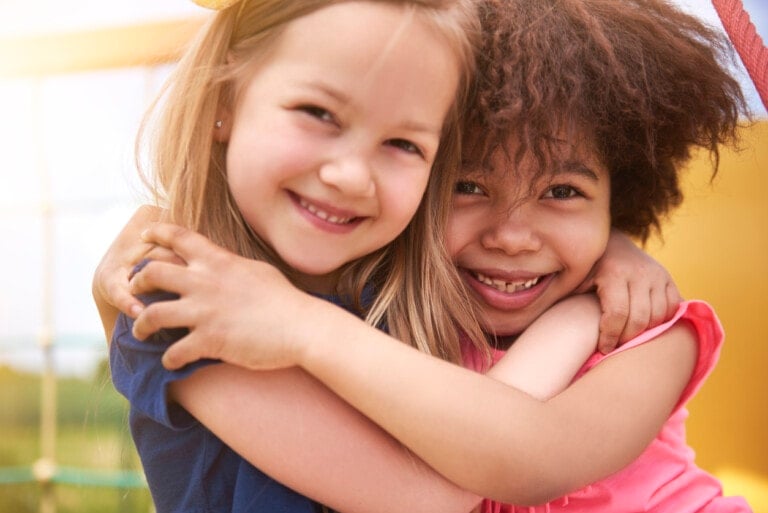As a parent, my days are spent juggling life, work, and parenting responsibilities and rushing from one activity to the next until I crash into bed. Then, repeat it all the next day. It’s easy to slip into patterns of reacting rather than making conscious parenting decisions when life is so busy. It seems like there is limited time for self-reflection or contemplation when you’re trying to raise tiny humans. If you have ever felt the same, almost like you are stuck on autopilot, you might want to learn more about mindful parenting.
What Is Mindful Parenting?
Mindfulness is not new; it has been practiced for centuries and comes from Buddhist traditions.1 However, mindfulness has recently been expanded and applied to parenting.2 Mindful parenting involves parents learning to become aware of the present moment and focus on themselves (their thoughts, feelings, and behaviors) and their children in intentional, present, and nonjudgmental ways.3
The parent-child relationship quality strongly influences a child’s emotional, social, and cognitive development.4 It’s normal across all stages of development for our children to be oppositional or challenging at times. This can lead to parents becoming stressed, which activates stress hormones (in response to a threat). This activates our immune system and, in turn, triggers certain emotions and can change or influence how parents behave or react to their children.5
When parents struggle with stress, they can sometimes rely on automatic or unhelpful patterns of behavior, like snapping, being reactive, being overly controlling, rejecting, or being less affectionate toward their children. These are not particularly effective parenting strategies and can result in more challenging behaviors expressed by their children.5 Cue a vicious reaction cycle from parents and kids alike.
Mindful Parenting Breaks Patterns
This is where mindful parenting comes into play, as it helps break these patterns. Mindfulness parenting allows us to break automatic (negative) parenting behaviors through nonjudgment and acceptance of both our kids and ourselves. This results in increasingly positive parent-child interactions, better resilience, and coping through compassion, acceptance, and kindness.3 Mindful families learn to respond, not react. When you don’t react, you give yourself space and an opportunity to respond consciously, free from judgment, shame, or other strong feelings. And when we choose our actions, we can better align ourselves with our parenting goals or intentional actions. In addition, when we have space, we can process our strong emotions or unhelpful thoughts and purposefully implement coping strategies. We also see our children’s behavior as communication and can be more empathetic and attuned to their needs.
Benefits of Mindful Parenting
Practicing mindful parenting helps promote a healthy relationship with our kids as we are more attuned, engaged, and empathetic toward them. In addition, there can be a whole range of benefits, such as:6
- Improved feelings of satisfaction in our experience of parenting
- Less anxiety and stress
- Increased and improved communication between parents and children
- Reduced hyperactivity in children
- Reduced aggression
- Fewer feelings of depression
Key Factors of Mindful Parenting

There are five key factors associated with being a mindful parent:7
1. No Judgment
Accept both yourself and your child without judging your (or their) thoughts, feelings, and behaviors. Understanding that everyone makes mistakes removes guilt, shame, or other strong feelings. Instead, you can see these situations as opportunities for learning. You learn that neither you nor your child are perfect, and your expectations for both are more healthy and realistic.
2. Be Present and Give Your Full Attention
When you’re a busy parent, this one can be hard. Your little one wants to show you a wonderful rock they found at the park. (True story: I had to listen to a five-minute blow-by-blow of all the merits of this one particular rock!) But in reality, your mind is being pulled in a hundred directions — what’s for dinner, when does Jenny need to be picked up from piano lessons, your overdue work project. Mindful parenting is about stopping these racing thoughts and focusing on what is happening now. This means being fully present, listening, engaging with your child, and giving them your full attention.
3. Compassion
Be understanding, compassionate, and empathetic to both you and your child. No one is perfect. Mindful parenting is about reassuring yourself and your child that you are wonderful, lovable, and acceptable, just as you are. It gives you both the grace and the space to make mistakes.
4. Emotional Awareness
Tune into those feelings. We often try to avoid strong feelings or particular feelings that are uncomfortable in some way. But when we ignore or push away these emotions, we miss the chance to explore them and figure out what need is underpinning that emotion. We also miss out on opportunities to address issues or problem-solve things that will help our well-being now and in the long term.
5. Manage Those Emotions
When we can identify the emotion, we are better equipped to cope with or manage the feeling. For example, we deal with anger differently than sadness. If we can regulate our emotions and pause or take stock of a situation, we are more able to take a conscious or intentional step forward instead of reacting or responding to our strong emotions.
Mindful Parenting for ADHD
One of the key benefits of mindful parenting is reduced hyperactivity in children.6 There is some research indicating that mindful parenting practices can support several symptoms of attention deficit hyperactivity disorder (ADHD) in children.3 ADHD is not just about attention; it also influences communication, social interactions, routines, and the ability to plan and coordinate things. It doesn’t just affect children with the diagnosis, either, but their entire families. Parents can become stressed or overwhelmed, resulting in those automatic reactions mentioned above. This family stress can make it harder to manage a child’s ADHD, which further amplifies the stress.
Mindfulness can help break this draining and distressing cycle.3 When you practice mindfulness, you can persevere, be flexible and responsive, be accepting of your child, and find the positives during challenges. This allows you to all be more resilient and able to cope.3
Examples of Mindful Parenting
So, what does mindful parenting look like? Let’s say your child is trying to build a block tower but keeps knocking it over, and eventually, they throw the blocks. Your instinct might be to shout at them, “Stop throwing your toys. You’re going to break them!” Or snatch the toys and pack them away. Mindful parenting would involve pausing to assess your and your child’s emotions and then consider a way forward. You might reflect on things like:
- What’s happening for me, and why?
- What am I thinking and feeling?
- What is my automatic reaction?
- What am I going to do instead?
- What’s happening for my child?
- Is there a message or feeling underpinning their behavior?
- How can I help us both regulate and manage our emotions?
- I feel some strong emotions, but it doesn’t mean I am a bad parent; it was a challenging situation.
- My child is not a bad kid; they were frustrated because they couldn’t make the block tower stay up. It’s okay that they aren’t perfect all the time. Perhaps there is something I can teach them or support them with to reduce their frustration or help them cope more healthily next time.
Ultimately, you might respond to your child by sitting with them, naming their emotions, helping them manage angry feelings, or patiently showing them how to build a block tower that will stay upright.
Here’s another example: At the supermarket, your child spots the candy they want and starts having a tantrum because you said “no.” Your instinct could be to give in and hand over the candy or flee the store. A mindful parent might take the approach of considering their child’s feelings and accepting them. Instead of giving in, running away, or even snapping, they might allow their child to experience discomfort and then name and accept their child’s feelings. “I can see you are mad right now. It’s okay to feel upset you didn’t get the candy you wanted.” Then, offer them support to cope with those big feelings. “I’m right here if you need a hug or want help managing that big angry feeling. Just tell me when you are ready.”
How To Be Mindful With Your Kids

It takes time to learn mindfulness, but remember that you don’t have to be perfect; you have to learn how to “tune in” to the present moment and “tune out” the background noise. Some strategies could include:
- Pause: Instead of jumping into action, take a moment. If there is a crisis or a safety issue, go right ahead and react. But I’m not talking about those moments. Unless something is critical, it’s okay to take stock for a moment and figure out what you want and need to manage the situation.
- Stop forward planning: Instead of the “what ifs” or “what next,” try to tune those out and stop focusing on the past or the future. Just be in the moment.
- Get in touch with your senses: A great way of tuning into the present is by paying attention to your senses. Name five blue things you can see, listen out for three unique sounds you can hear around you, or take off your shoes and wriggle your feet on the carpet/sand/grass and feel the sensation.
- Acceptance is key: Acceptance doesn’t mean you have to like something (or that you won’t take action to avoid it in the future if you can). It’s about acknowledging that something has happened and that it’s acceptable. Extend acceptance to you and your child — your behaviors, thoughts, and feelings.
- Take a breath: When you are pausing, take a deep breath! Calm breathing can help reduce stress.8 Remember when we spoke about stress earlier? It can change how you react and respond. So, bust your feelings of stress by taking a deep, slow breath and returning to the present moment.
It’s easy to slip into bad parenting habits or focus on the challenges. But when you practice mindful parenting, you bring awareness to the good moments instead. You will bring your attention to what your child is trying to communicate, notice the emotions underpinning their message, or see some positives you had missed when you were focused on the negatives. You will also be more kind, compassionate, and empathetic to them and yourself. Practicing mindfulness will improve your child’s resilience and well-being, but you will likely reap the rewards, too!































